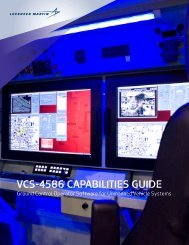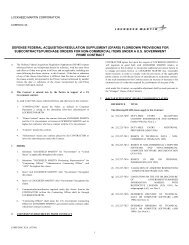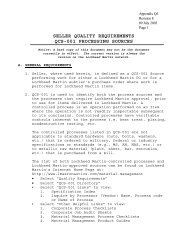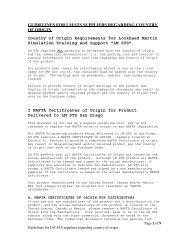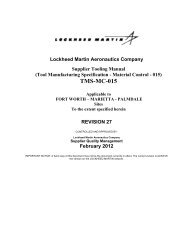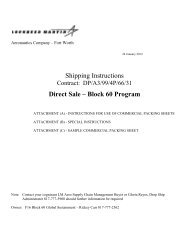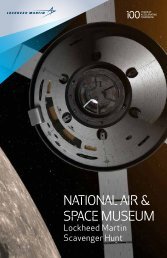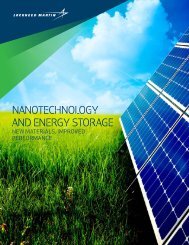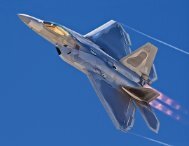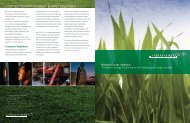INFUSED CARBON NANOSTRUCTURES - Lockheed Martin
INFUSED CARBON NANOSTRUCTURES - Lockheed Martin
INFUSED CARBON NANOSTRUCTURES - Lockheed Martin
Create successful ePaper yourself
Turn your PDF publications into a flip-book with our unique Google optimized e-Paper software.
<strong>Lockheed</strong> <strong>Martin</strong> MS2<br />
1801 State Route 17C<br />
Owego,<br />
<strong>Lockheed</strong><br />
NY<br />
<strong>Martin</strong><br />
13827,<br />
Corporation<br />
USA<br />
www.lockheedmartin.com<br />
6801 Rockledge Drive<br />
Bethesda, MD 20817<br />
Copyright<br />
www.lockheedmartin.com/nano<br />
©2013 <strong>Lockheed</strong> <strong>Martin</strong> Corporation<br />
All rights reserved<br />
PIRA#<br />
Copyright<br />
XXXXXXXXXXXXX<br />
©2013 <strong>Lockheed</strong> <strong>Martin</strong> Corporation<br />
All rights reserved<br />
3/2013<br />
CET201302014<br />
GS9509<br />
<strong>INFUSED</strong> <strong>CARBON</strong><br />
<strong>NANOSTRUCTURES</strong><br />
MANUFACTURING SOLUTIONS FOR<br />
NEXT-GENERATION PRODUCTS
<strong>Lockheed</strong> <strong>Martin</strong>’s Applied NanoStructured<br />
Solutions (ANS) subsidiary has created a<br />
process to infuse multi-wall carbon nanotubes<br />
with glass, carbon, and ceramic fibers for<br />
continuous, high-volume production. These<br />
infused carbon nanostructures (CNS) are<br />
versatile platforms for users to create the<br />
next-generation of low-cost composite<br />
materials with enhanced electrical and<br />
thermal conductivity, advanced shielding<br />
properties and protection against lightning<br />
strikes. Low-cost manufacturing processes<br />
and the unique architecture and properties of<br />
carbon nanostructures offer cost-effective,<br />
multi-functional performance across multiple<br />
applications in defense, aerospace, automotive<br />
and commercial applications.<br />
THE POWER OF<br />
CONTROLLED<br />
ARRANGEMENT<br />
ANS engineered its carbon nanostructure materials<br />
to be compatible with established manufacturing<br />
processes, reducing both design and production costs<br />
for end-users. The unique manufacturing process ANS<br />
created thoroughly infuses carbon nanotubes (CNT)<br />
onto glass, carbon or ceramic fiber substrates in a<br />
precisely controlled manner. Unlike materials merely<br />
coated with carbon nanotubes, ANS’ cross-linked<br />
and highly entangled arrangement imparts enhanced<br />
electrical, thermal, and structural properties of<br />
nanotubes to end-products. This is done as one endto-end<br />
production without requiring costly secondary<br />
materials and processes.<br />
The critical infusion of the nanotubes occurs through<br />
an innovative and scalable roll-to-roll process now in<br />
operation at the ANS Pilot Scale Production facility in<br />
Baltimore, Maryland.<br />
ANS works closely with end-users to create a<br />
product-specific, CNT-matrix blend for a user’s select<br />
applications. After developing and validating product<br />
prototypes, ANS will license appropriate patents<br />
and production details to commercial manufacturers<br />
that are configured for their existing production<br />
infrastructure.<br />
For manufacturers, a substantial advantage of the<br />
cross-linked CNS network is that it does not shed or<br />
produce respirable nanotubes that can affect health.<br />
Recognizing that carbon nanostructure technology does<br />
not present an unreasonable risk, the Environmental<br />
Protection Agency has issued a Premanufacture Notice<br />
(PMN) for CNS materials in thermoplastic matrices.<br />
Subsequent PMN’s will follow, as material forms for<br />
specific applications are identified. <strong>Lockheed</strong> <strong>Martin</strong><br />
researchers are also collaborating with the National<br />
Institute for Occupational Safety and Health (NIOSH)<br />
to establish best practices and procedures to mitigate<br />
employee exposure.<br />
Versatility in Action<br />
<strong>Lockheed</strong> <strong>Martin</strong> has demonstrated that CNS can<br />
enhance performance of materials used in a wide range<br />
of applications, including:<br />
• EMI and cable shielding<br />
• Lightning strike protection<br />
• Structural health monitoring<br />
• Composite materials for lightweight structural<br />
components<br />
One use of the ANS-engineered carbon nanostructures<br />
is to protect composites in modern aircraft from<br />
lightning strikes. While composite materials provide<br />
many advantages, they can be severely damaged by<br />
lightning strikes. The industry solution to date has been<br />
to add a metal mesh layer to the aircraft design, but<br />
ANS engineers have demonstrated that adding their<br />
carbon nanostructures to aerial composite materials can<br />
provide a light-weight, low-cost alternative to enhance<br />
protection.<br />
The company has also crafted CNS-infused braided<br />
shielding to protect against electromagnetic<br />
interference, using both glass and carbon fiber<br />
substrates. This cabling offers shielding effectiveness<br />
from direct current to 40 Ghz, a 30-70 percent weight<br />
savings compared to standard shielding components, and<br />
costs significantly less than braided copper shielding,<br />
commercial metal-clad fibers, and traditional CNT<br />
materials.<br />
Rapid Reengineering<br />
<strong>Lockheed</strong> <strong>Martin</strong> has embarked on a challenge to<br />
redesign the Desert Hawk III unmanned aircraft system<br />
(UAS) using nanocomposite materials. Engineers were<br />
challenged to increase the aircraft’s durability without<br />
increasing the weight of this 8-pound surveillance<br />
workhorse. They used ANS-infused composites to<br />
remanufacture the Desert Hawk’s nacelle and motor<br />
compartment, camera bay, and rear fuselage and tail<br />
assembly. Two redesigned aircraft have received Federal<br />
Aviation Administration (FAA) approval for flight in<br />
commercial airspace. <strong>Lockheed</strong> <strong>Martin</strong> engineers will<br />
complete this makeover with CNS composite propellers<br />
and wings. Based on this success, the company plans to<br />
incorporate CNS-infused composites into many of its<br />
UAS platforms, improving their durability, increasing<br />
mission lifetime, and lowering manufacturing costs.




